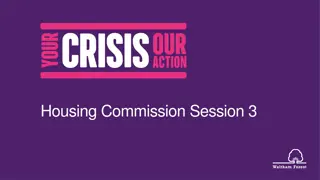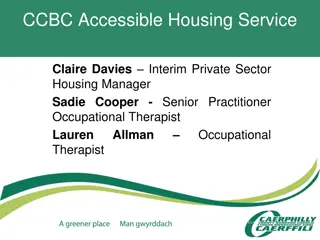Impact of VAWA Legislation on Multi-Family Housing Programs
The Violence Against Women Act (VAWA) has had significant impacts on multi-family housing programs in the United States since its introduction in 1994. The reauthorizations in 2005 and 2013 expanded the scope of the legislation to include various housing programs administered by HUD. Implementing VAWA requirements, including utilizing specific forms and creating emergency transfer plans, has been a key focus for owners/managers to ensure compliance and support victims of domestic violence, dating violence, and stalking. Recent HUD guidance has provided clarity on implementation, with new forms becoming effective on December 16, 2016.
Download Presentation

Please find below an Image/Link to download the presentation.
The content on the website is provided AS IS for your information and personal use only. It may not be sold, licensed, or shared on other websites without obtaining consent from the author.If you encounter any issues during the download, it is possible that the publisher has removed the file from their server.
You are allowed to download the files provided on this website for personal or commercial use, subject to the condition that they are used lawfully. All files are the property of their respective owners.
The content on the website is provided AS IS for your information and personal use only. It may not be sold, licensed, or shared on other websites without obtaining consent from the author.
E N D
Presentation Transcript
The Violence Against Woman Act VAWA Implementing New Forms Released December 16 2016
VAWA - Introduction The Violence Against Women Act (VAWA) is a landmark piece of legislation that sought to improve criminal justice and community-based responses to domestic violence, dating violence, sexual assault and stalking in the United States. Originally enacted in 1994, VAWA has since been reauthorized several times. The 2005 reauthorization first included provisions that applied to housing, specifically the Section 8 and public housing programs, by conforming the laws governing these programs. At the time, the U.S. Department of Housing and Urban Development (HUD) determined the provisions contained in VAWA 2005 were self-implementing, which meant owners were not to wait for regulatory guidance to implement the provisions of the law. Since that time, VAWA 2005 has been established through HUD Notices and incorporated into Change 4 of the HUD Handbook 4350.3.
VAWA 2013 Impact on Multi-Family Housing In 2013, when VAWA was again reauthorized by President Obama, it expanded its list of covered programs to include the LIHTC and HOME programs as well as numerous other programs administered by HUD and USDA Rural Development. VAWA is written in such a way that responsibility for implementation rests on the shoulders of Owners/Management Companies. The IRS deemed that the implementation of VAWA exceeds their authority since their role is to enforce tax law. Many State Housing Agencies who administer the HOME & LIHTC programs have only been educating owners and not yet monitoring for violations as they awaited more guidance from HUD. HUD ADVISED IN 2013 THAT FURTHER GUIDANCE WOULD BE FORTHCOMING
VAWA 2013 Impact on Multi-Family Housing IFA s Current Enforcement: The IFA Compliance Manual of 2015 requires all LIHTC owner/managers to comply with the requirements of the VAWA Act and to utilize the following forms: HUD Form 91066, Certification of Domestic Violence, Dating Violence or Stalking, HUD Form 91067, Lease Addendum Beyond that, IFA advised that the property is to establish an emergency transfer plan and to maintain documentation relating to victims who requests protection under VAWA. (pages 22-23) Findings were issued via a State Notice of Non- Compliance if a project was not using the required HUD forms during certification or recertification.
New HUD Guidance Federal Register 11/16/2016 The long awaited guidance has finally been released, effective 12/16/2016. Four new forms have been created by HUD. HUD advises that owners/management companies may customize these forms for their properties, as long as they contain the same information and language. HUD has provided direction on the creation and implementation of the Emergency Transfer Plan that is to be put in place for each project by the owner/property management company. They have also advised of a deadline regarding the implementation of this plan. HUD advises that the current form HUD-91067 (Lease Addendum) should continue to be utilized, but that they will be updating this form in the future.
HUD VAWA Forms Appendix A: HUD-5380 Notice of Occupancy Rights Under the Violence Against Women Act The HUD-5380 provides information to the household of their rights under VAWA. This form replaces the current HUD-91066 form that has been required by IFA since 2015. It is provided as a Word fill-in form so that it may be customized. During Implementation Phase: It is to be provided to each existing adult household member by Dec. 16, 2016 : At move-in if their move-in date is after 12/16/2016. During the household s annual recertification or lease renewal process. With the execution of the Student Status certification for 100% LIHTC projects with no agency covenants. THIS IS NOW A REQUIRED FORM (Replaces the HUD-91066)
HUD VAWA Forms Appendix C: HUD-5382 Certification of Domestic Violence, Dating Violence, Sexual Assault or Stalking and Alternate Documentation The HUD-5382 form is to be completed by any household member who is seeking VAWA protection while residing in your property and is effective as of 12/16/2016. It may be completed by the household member seeking to invoke their VAWA rights or someone on their behalf. It states that the household member may be required to provide third-party documentation. However, IFA suggests that you practice care when doing so. This form must be used as is and care must be taken that the most current version is being used It must be provided to the household at the same time that you distribute the HUD-5380. THE DISTRIBUTION OF THIS FORM IS REQUIRED
HUD VAWA Forms Appendix D: HUD-5383 Emergency Transfer Request for Certain Victims of Domestic Violence, Dating Violence, Sexual Assault or Stalking The HUD-5383 form is to be completed by any household member who is seeking an emergency transfer while residing in your property and is effective as of 12/16/2016. HUD advised that the owner/agent MAY require tenants to provide a written emergency transfer request. You may also accept other written or oral requests for a transfer. You MAY require third-party documentation; the form lists a variety of acceptable documentation. However the form advises the tenant that they only need to provide documentation if it is safe for them to do so. IFA suggests that you practice care when requesting any verification documentation.
HUD VAWA Forms Appendix B: HUD-5381 Model Emergency Transfer Plan for Victims of Domestic Violence, Dating Violence, Sexual Assault or Stalking Must be developed and implemented by June 14, 2017 using the HUD-5381 as a model. The plan must establish recordkeeping and reporting requirements. There does not appear to be a requirement to update this plan on a regular basis, however it will likely need to updated as HUD releases further requirements in the future. THIS FORM SHOULD BE USED AS A GUIDE PER HUD
HUD VAWA Forms HUD-91067 Lease Addendum This remains a required form to be in compliance with IFA s policies on VAWA. Each adult household member must execute their own lease addendum during certification. The lease addendum(s) must also be re-signed when a new lease is executed. If your lease has a clause by which it goes month to month at the end of the original lease term, then you do not need to have them re-sign the lease addendum. HUD has advised that this form is being updated; we will notify you when this occurs. THIS IS A REQUIRED FORM
IFA Required Form VAWA Acknowledgement of Receipt IFA has developed a new required form to be signed by each adult household member indicating their acknowledgement of receipt of both the HUD-5380 and HUD-5382. To catch up, to be signed and placed in tenant file at recertification, lease renewal or when student status certification done at 100% LIHTC projects. Going forward to be signed and placed in file at move-in of household or additional household member. Section 8/RD projects already using HUD VAWA forms may use their existing acknowledgement form.
HUD VAWA Forms Instructions from HUD Beginning 12/16/2016 the owner/manager must provide the HUD-5380 and the HUD-5382 as follows: During Implementation: Each household must receive these forms either at move in, during the annual recertification, or during lease renewal process. The forms do not need to be distributed to an existing household thereafter UNLESS a negative action is taken (such as an eviction notice, or denial of an applicant). The forms do not have to be provided to every applicant on the waiting list. Each adult household member must receive these forms along with any eviction or termination of assistance.
HUD VAWA Forms Instructions from HUD cont. By June 14, 2017 owners/management companies ARE REQUIRED to develop and implement an Emergency Transfer Plan, establish recordkeeping and reporting requirements using HUD-5381 as a guide. If your plan includes a requirement that a written notification be provided in order to request an emergency transfer, you can again provide the HUD- 5383 to the tenant seeking the transfer. Your plan should include information about your documentation requirements (see the HUD-5383 for examples of possible 3rd party documentation.) IFA suggests that you practice care when requesting any verification documentation.
HUD VAWA Forms IFA Recommendations Though HUD only suggests that you require tenants to provide a written emergency transfer request, IFA would recommend that you require a written notification on HUD-Form 5383, unless it is otherwise unsafe for the tenant to do so. Though HUD only suggests that you require tenants to provide 3rd party verification to demonstrate that they are eligible for an emergency transfer, IFA would recommend that you require this documentation be provided, unless it is otherwise unsafe for the tenant to do so. Like Fair Housing, failure to ensure that property rules are equally applied to all households could lead to a complaint being filed and investigated by the Department of Justice (DOJ) A DOJ finding could lead to the issuance of 8823 or State Notice of Non-compliance
HUD VAWA Forms Summary of IFA Requirements A written acknowledgement of the receipt of HUD-5380 and HUD-5382 must be signed by each adult household member during initial certification. It must also be signed by any new adult household member that joins an existing household. An individual HUD Form 91067 must be executed by each adult household member when a new lease is signed by the household or a new adult household member joins an existing household. An Emergency Transfer Plan must be developed and implemented by June 14, 2017. It should be submitted to IFA with other project level documents at the time of the project s compliance monitoring visit. The Owner s Certification of Continuing Compliance will contain a statement certifying to the properties adherence to the requirements of VAWA.
HUD VAWA Forms Conclusion All four new VAWA Forms as well as the HUD-91067 will be available on the IFA Website on the Housing Tax Credit and HOME Program Compliance Information page. http://www.iowafinanceauthority.gov/Home/DocumentSubCategory/195 In addition the new VAWA forms can also be found on HUDClips by using the following link: https://portal.hud.gov/hudportal/HUD?src=/program_offices/administration/hudcli ps/forms/hud5a























